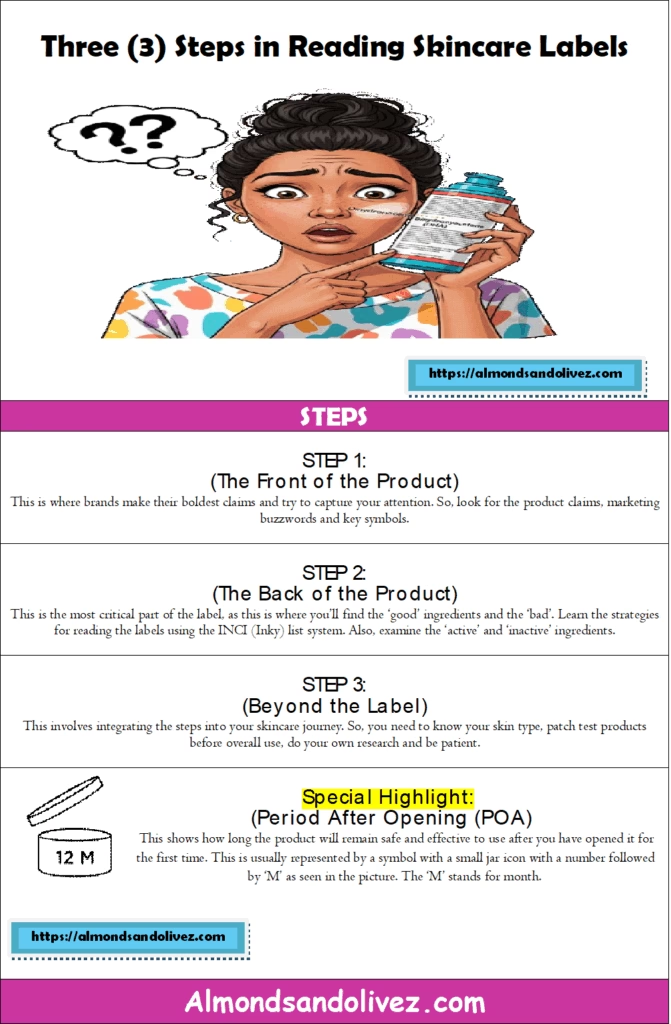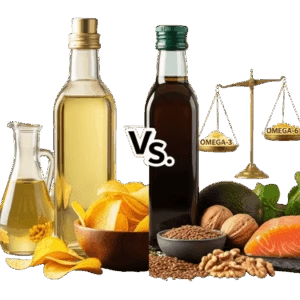TABLE OF CONTENTS
Have you ever found yourself in the skincare aisle, staring blankly at a product, utterly baffled by the tiny print and seemingly endless list of scientific-sounding ingredients? You’re not alone. Skincare labels can often feel like a secret code to be decoded by consumers, leaving us guessing if a product will truly deliver on its promises or just irritate our skin.
But here’s the empowering truth: understanding skincare labels isn’t rocket science. With a few key strategies, you can become a savvy shopper, avoid unnecessary irritation, and finally invest in products that truly work for your unique skin.
In this article, we explore the three (3) steps in reading any skincare label as well as explore the two (2) main types of ingredients to look out for when shopping the skincare aisle. Let’s Discuss!
You can read more about the skin in this article.
The Discussion
Understanding skincare labels is crucial for making informed choices for your skincare needs. When you understand how to read the label, you will be able to decipher (yes, decipher 😊) a product’s safety and effectiveness.
However, reading and understanding the labels can be a chore at times, which prevents consumers from making the right choices for their skincare needs and ultimately, health. This is because what you put on your skin can directly impact your overall health, as the skin is the largest organ of the body. Therefore, we must be careful about the products we use daily.
One of the ways in which we can learn how to read and understand skincare labels is through the standards set by what is known as the INCI (inky) list. INCI stands for (International Nomenclature of Cosmetic Ingredients).
According to the International Cosmetic Ingredients Dictionary and Handbook, it is a standardized system used for identifying skincare or cosmetic ingredients using internationally recognized names, especially for product labelling purposes (International Cosmetic Ingredients Dictionary and Handbook, 2006). The ingredient names are published by the Personal Care Products Council (PCPC) in the International Cosmetic Ingredients Dictionary and Handbook.
So, what the INCI (Inky) list does is to set the standards by which cosmetic manufacturers must operate as it relates to the ingredients on the products. Therefore, it ensures consistency and a global way of understanding the way that manufacturers must list ingredients on their cosmetic products, regardless of the country or the language. This, in turn, helps with clarity and transparency when it comes to cosmetic labelling.
Therefore, the first few ingredients on a product (usually the first 5 -7 ingredients) are the main ingredients of the product and where you should find the ‘actives’ (active ingredients). These ingredients must be written in descending order.
The first ingredient will be the primary ingredient and the most concentrated, and so forth. After these crucial sets of ingredients, those present at or below what is known as the one (1%) percent, can be listed in any order, and as such, do not represent their level of concentration within the product.
In this article, we will explore the three (3) steps in reading skincare labels, taking the INCI (International Nomenclature Cosmetic Ingredient) system into consideration or what is commonly known as ‘the inky list.’ The article will also delve a little bit into the main types of ingredients that make up a product.
This will help you to easily identify the targeted ingredients, especially if you are searching for a product to help with a particular skincare need. The steps to be discussed also include tips on how to make the right choices when purchasing your skincare products.
3 Steps in Reading Skincare Labels
- Step 1: The front of the product.
- Step 2: The back of the product.
- Main ingredients – Active and Inactive
- Step 3: Beyond the Label – Making informed choices
Step 1: The Front of the Product
The front of a skincare product is like its billboard. It is where brands make their boldest claims and try to capture your attention. While helpful for a quick overview, it is crucial to approach this section with a critical eye. So, look out for these when purchasing:
- Product Name & Key Claims: Look for terms like “Hydrating,” “Anti-Aging,” “Brightening.” These tell you the product’s primary intended purpose. However, be aware that terms like “dermatologist-tested,” “hypoallergenic,” or “non-comedogenic” are usually not regulated, so brands often use these to capture consumers’ attention.
While it is not done by all brands, it is something to take note of when purchasing your skincare products. Also, just because a product may claim, for example, to be ‘non-comedogenic’ doesn’t mean it will not block your pores, as I have used products of this nature and had to stop, as I experienced breakouts. So, often using these terminologies simply means that the product was used by a few people who did not react badly during testing.
- Marketing Buzzwords: Look for phrases like “clean beauty,” “natural,” “non-toxic,” or “chemical-free” when purchasing your skincare products. While these may sound appealing, they may lack standardized legal definitions. Therefore, a product labelled “natural” could still contain potent natural irritants. So, always refer to the ingredient list for the real story.
- Key Symbols to look out for:
- Look for how long the product will remain safe and effective to use after you have opened it for the first time. This is represented by the symbol POA, which means Period After Opening (PAO). This symbol is a small open jar icon with a number and followed by an “M” (for months). For example, you may see something like – “6M,” “12M,” “24M”. The “6M” means six (6) months, the “12M” means twelve (12) months and the “24M”, twenty-four (24) months. You will usually see this icon on the front side of the product or at the bottom. (EU Cosmetic Directory). This information is vital, especially if the product is sensitive in nature. Therefore, it is recommended that you discard products that pass their PAO date to prevent bacterial contamination and ensure efficacy.
- Cruelty-Free/Vegan Logos: If ethical considerations are important to you, look for the Leaping Bunny logo for cruelty-free verification or the Vegan Society logo for vegan certification. Sometimes you will only see it in words, for example, ‘cruelty-free.’ So, you may have to check the product, both the back and the front.
- Net Content: This is usually displayed in millilitres (ml) or fluid ounces (Fl oz) and indicates the actual amount of product you’re purchasing.
Step 2: The Back of the Product – The INCI (Inky) List
The back of the product is the most critical part of the label, as this is where you’ll find the ‘good’ ingredients and the ‘bad.’ As indicated in the ‘Discussion’ Section above’, the ingredients list on your products follows the INCI (International Nomenclature Cosmetic Ingredient) system, or what is often called the ‘inky list’. The INCI system is a standardized worldwide system. So, while the ingredient listing might look complex, the order is what you need to pay much attention to.
According to the INCI (inky) system, ingredients are listed in descending order of concentration. This means:
- The ingredients at the very top of the list make up the largest percentage of the product’s formula.
- Ingredients that make up less than 1% of the formula can be listed in any order at the very end.
Therefore, when you are scrutinizing a product, focus your attention on the first set of ingredients. This may mean the first 5-7 ingredients or even more, as this will depend on the product and what it promises. These are typically the bulk of the formulation – often water, emollients, emulsifiers, and sometimes your key active ingredients.
Now, let’s look dissect the two (2) main types of ingredients:
- The ‘Active Ingredients’ and the ‘Inactive Ingredients.’ The active ingredients are the ones responsible for delivering the product’s promised benefits. You want to see these higher up on the list for maximum impact. For example, if the product is touted to be:
- Hydrating and supporting the natural barrier of the skin, then you should see ingredients like Hyaluronic Acid, Glycerin, Ceramides, Squalane and Urea as part of the initial listing of ingredients. (Harwood et al. 2025).
- For Brightening or Antiaging or both, then look out for ingredients like vitamin C (Ascorbic Acid and any derivatives such as Ascorbic Glucoside), Retinoids (Retinol, Retinal, etc.) and Alpha Arbutin and Peptides among others.
- For Exfoliation & Acne: Identify AHAs (Glycolic Acid, Lactic Acid), BHAs (Salicylic Acid).
- For Soothing & Anti-Redness: Look for Centella Asiatica, azelaic acid, etc. (Park, 2021; Powell, 2005; Gollnick and Layton, 2008).
- The Inactive Ingredients or Excipients. These ingredients do not make up the ‘active ingredient’ listing of the product and thus do not have any direct therapeutic effect. Sometimes, they are often seen as potential irritants or allergens (US Food and Drug Administration).
However, these ingredients aren’t inherently “bad,” and many people tolerate them well. But, if you have sensitive, reactive, or acne-prone skin, it’s wise to be aware of them, especially if they appear high on the list of ingredients for the product you are purchasing. Here are some of the inactive ingredients you will find in cosmetic products.
- Fragrance / Parfum: This is one of the most common irritants and allergens. If you have sensitive skin, opt for “fragrance-free” products.
- Alcohol Denat. (Denatured Alcohol) / Ethanol: This ingredient can be very drying and irritating, especially if it’s among the first few ingredients. Look for these fatty alcohols instead: Cetyl Alcohol (or palmityl alcohol, Stearyl Alcohol). These alcohols are typically different and generally beneficial.
- Certain Essential Oils: While essential concentrated oils are often beneficial to our skin, some can be irritating, for example, lavender oil, tea tree oil and peppermint oil, etc. Therefore, look for these in the products you are purchasing.
- Dyes: You will often see dyes listed by CI (Colour Index) or numbers (e.g., CI 77491). Dyes in general can be irritating to some individuals. Also, with the recent ban of ‘Red Dye No.3”, you need to ensure that this dye or dyes in general are not in the products you are desirous of purchasing. You can read more Red Dye No. 3 here.
- Preservatives: While preservatives are needed to keep the product safe from microbial growth as well as lengthen its shelf life, they can be irritating to some individuals. Therefore, if you have sensitive skin or are aware that you are allergic to certain preservatives, then you want to ensure that you look for these in the product ingredient listing when purchasing. Preservatives include parabens, formaldehyde, which can be very harmful to our overall health (Knop & Pilato, 1989).
You can read more on exfoliants, formaldehyde and other skincare ingredients to avoid in these articles:
Step 3: Beyond the Label – Making Informed Choices
So, you have deciphered the label; now it’s time to integrate that knowledge with your personal skincare journey. Here are some tips to get you on that path.
- Know Your Skin: This is paramount. This includes knowing your skin type (e.g., normal, oily, combination, etc.). Is your skin acne-prone or sensitive? Do you suffer from hyperpigmentation, or are you looking for products for antiaging? When you understand your skin, you are better able to make informed choices when shopping for skincare products.
- Patch Test, Patch Test, Patch Test! This cannot be exhausted, especially for new products or if you have sensitive skin. As such, apply a small amount of the product to a discreet area (e.g. behind your ear, on your neck, or inner forearm) for a few days before applying it to your entire face. This will allow you to see if you suffer any irritation or have an allergic reaction to the product.
- Do your own Research: While you might be prompted to buy a product promoted by your favourite social media influencer or via an advertisement, always ensure that you do your own research. Search for the product online and check out its ingredients. You can also check for reviews to get an idea of what others who have used it feel about it.
- Be Patient: Remember, no single product is a miracle cure. Consistency is key. Moreover, it takes time for skincare ingredients to show results (often several weeks to months).
Illustrative Summary
Here is an illustrative summary of the 3 STEPS IN DECODING/READING SKINCARE LABELS
Let’s Sum Up!
Decoding skincare labels might seem daunting at first, but following these three steps will help you gain the confidence and clarity you need as you peruse those skincare aisles. As such, you will move from feeling overwhelmed to empowered, making choices that truly benefit your skin and help you achieve your desired results.
Remember, a long ingredient list is not necessarily bad, and a short one isn’t always good. It’s about the quality and concentration of the ingredients that matter most to your skin. So, choose wisely.
So, now that we have explored how to read skincare labels, is this something that you will follow? Which of the steps was most surprising? Share it Nuh!
You can learn more about the skin and the different ingredients in products by reading the articles below or by watching related videos:
- Cosmetic, Toiletry and Fragrance Association, et al. International Cosmetic Ingredient Dictionary and Handbook. Edited by Tara E. Gottschalck and Gerald N. McEwen, 11th ed. / editors, Tara E. Gottschalck, G.N. McEwen , Jr., Cosmetic, Toiletry, and Fragrance Association, 2006.
- EU Cosmetics Directive (76/768/EEC) at the Wayback Machine (archived February 4, 2012), Annex VIIIa, modified by Directive 2003/15/EC
- Gollnick H, Layton A. Azelaic acid 15% gel in the treatment of rosacea. Expert Opin Pharmacother. 2008 Oct;9(15):2699-706. doi: 10.1517/14656566.9.15.2699. PMID: 18803456.
- Harwood A, Nassereddin A, Krishnamurthy K. Moisturizers. [Updated 2024 Feb 12]. In: StatPearls [Internet]. Treasure Island (FL): StatPearls Publishing; 2025 Jan-. Available from: https://www.ncbi.nlm.nih.gov/books/NBK545171/
- Knop, A., & Pilato, L.A (1989). Comprehensive Polymer Science and Supplements. Retrieved May 2019 from https://www.sciencedirect.com/topics/earth-and-planetary-sciences/formaldehyde
- Park KS. Pharmacological Effects of Centella asiatica on Skin Diseases: Evidence and Possible Mechanisms. Evid Based Complement Alternat Med. 2021 Nov 20;2021:5462633. doi: 10.1155/2021/5462633. PMID: 34845411; PMCID: PMC8627341.
- Powell, Frank. (2005). Clinical practice. Rosacea. The New England journal of medicine. 352. 793-803. 10.1056/NEJMcp042829.





